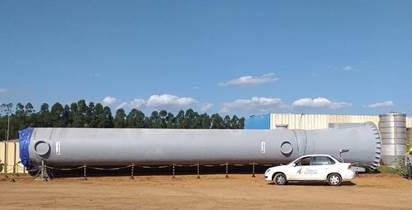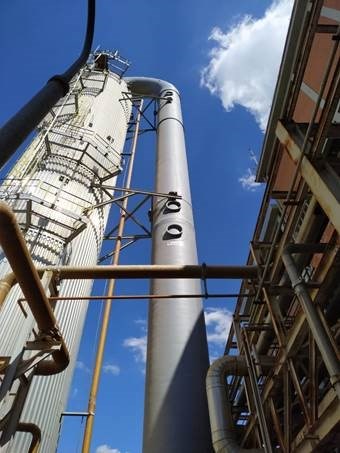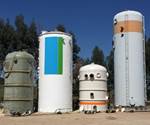Tecniplas extends useful life of composites equipment used in paper mill by 50%
Taking into accordance corrosive fluids and high process temperatures, the new FRP up flow tower is able to operate for 15 years without need for maintenance.

With a height of 42 meters, the tower was transported in two sections and assembled in the field. All photo credit: Tecniplas
In November 2020, Tecniplas (Cabreúva, Brazil), a manufacturer of tanks and special fiberglass-reinforced plastic (FRP) equipment, took advantage of FRP’s versatility and developed composite equipment for a paper mill, extending the equipment’s useful life by 50%.
According to Luís Gustavo Rossi, director of Tecniplas, said composite equipment was a flow tower used in the pulp bleaching process. “The customer has operated this type of equipment for a decade. However, in the last five years of use, some structural reforms were necessary, due to the high aggressiveness of the environment.” In addition to working with highly corrosive fluids, the tower operates at 70°C.
With the support of the resin manufacturer INEOS Composites (Dublin, Ohio, U.S.), Tecniplas' engineering department redid the structural calculations based on the ASME-RTP1 standard (for FRP vessels) and a 144 kilometer-per-hour wind load. With a diameter of 2,220 millimeters, the tower is 42 meters in height, with two 21-meter sections mounted in the field.

Up flow tower.
“After the first five years in operation, we verified a corrosion factor of about 1 millimeter per year,” says Rossi. Then, the company factored into the new tower’s lamination plan nine strand mats of 450 grams per square meter (g/m²) for the chemical barrier. In addition, all the equipment — liner, chemical barrier and structure — was produced with INEOS Composites’ Derakane Signia 411 vinyl ester resin.
Thanks to this new combination of raw materials, the new up flow tower is able to operate for 15 years, without the need for maintenance interruptions. “We were able to meet customer demand in a relatively simple way and 100% based on technical standards,” concludes Rossi.
Related Content
-
ZEBRA project demonstrates closed-loop wind recycling system
Consortium partners have proven the complete recycling of thermoplastic wind turbines via two manufactured wind blades, featuring reduced operating cost, CO2 emissions.
-
Composites manufacturing for general aviation aircraft
General aviation, certified and experimental, has increasingly embraced composites over the decades, a path further driven by leveraged innovation in materials and processes and the evolving AAM market.
-
Running shoe insoles get a lift with thermoplastic fiberglass tapes
FlexSpring insoles take advantage of unidirectional, continuous fiberglass and thermoplastics to enable next-level performance for the everyday runner.
















